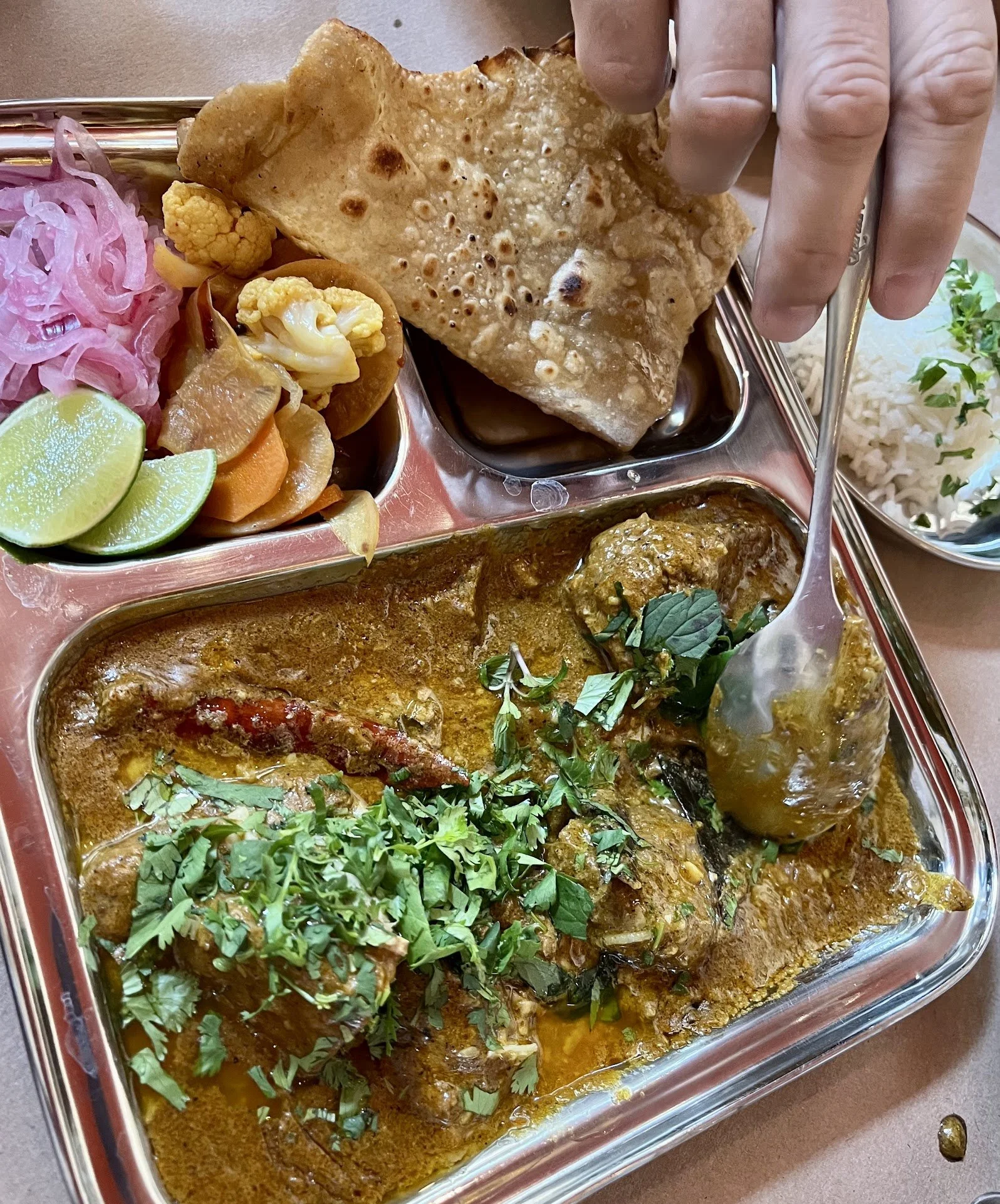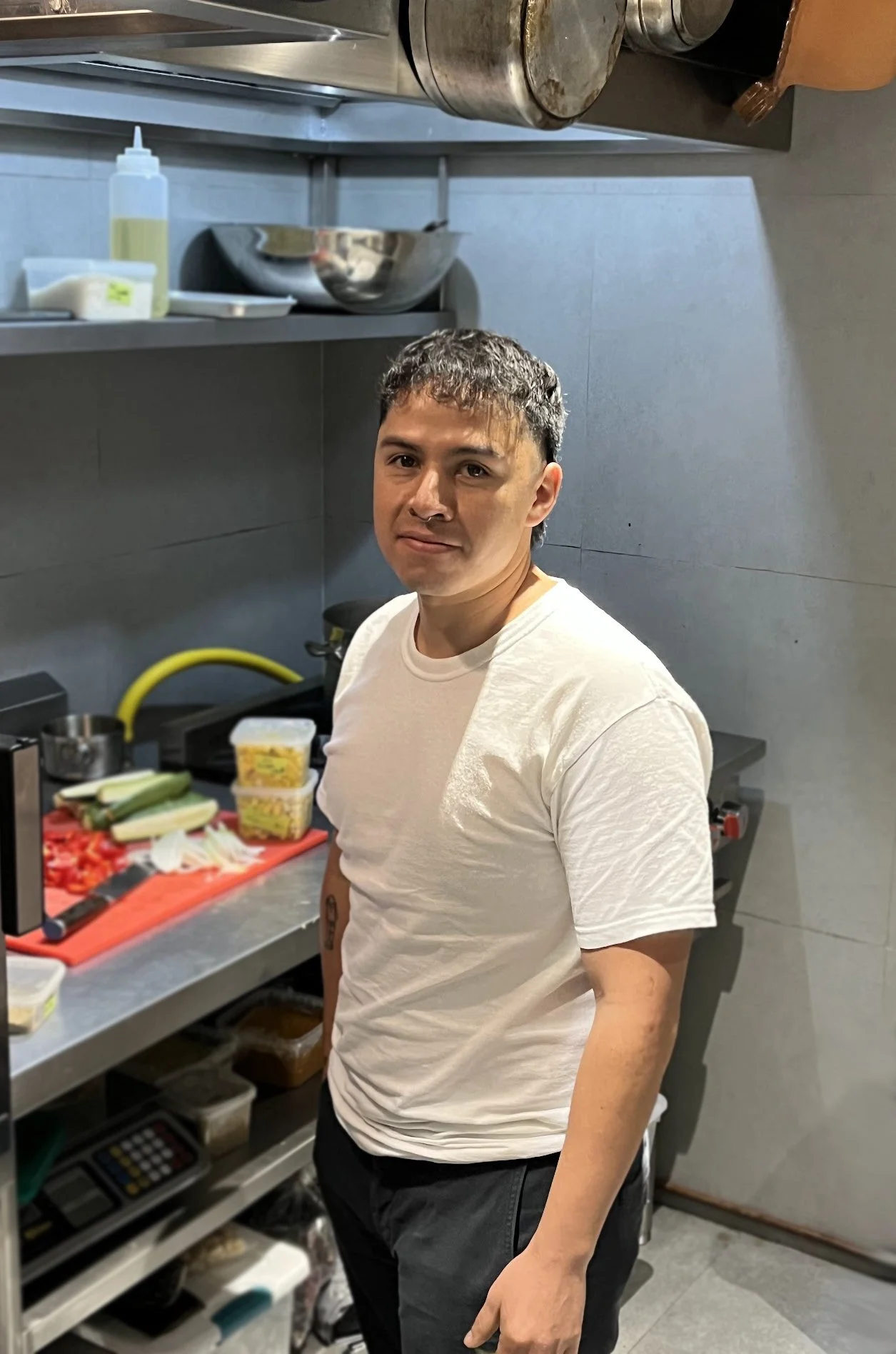Postcard from New Delhi: A conversation with chef Manish Mehrotra of Indian Accent
Indian and Mexican cooking are kissing cousins. The philosophy behind these two aggregations of cuisines is unique and similar: there is no doubt that masala and mole invite comparison. The common ground between Indian and Mexican cuisine certainly has a lot to do with the Spanish/Portuguese connection. They were the carriers of the chili, as well as tomato, potato, corn, zapote and other fruits to India. India sent us their bounty of spices.
Poet Octavio Paz, former Mexican ambassador to India, affirmed that the gastronomic repertoires of both countries, with their eccentric flavors and intense colors were "imaginative and passionate,” and he acknowledged their relationship.
Indian Accent at The Lodhi Hotel, New Delhi, Image by Raghav Pasricha
Chef Manish Mehrotra of Indian Accent in New Delhi, currently no. 30 on S.Pellegrino’s Asian 50 Best list, is well aware of the connection. He proudly stands behind his award-winning kitchen. His restaurant transcends the usual crescendo of fine-dining tasting menus. Many dishes are based on old-fashioned comfort foods, that is, dishes comforting to Indians. They do not forsake tradition but are odes to it, while acknowledging contemporary kitchen technology. One might even say that Indian Accent is the Pujol of India; chef Mehrotra thinks so. His mission is to educate the world about what Indian food, with its myriad regional varieties, can be--much as Enrique Olvera has done for Mexico and Gaston Acurio for Peru.
Baingan Bharta Cornettos, Fresh Feta Yogurt, Image by Rohit Chawla for Indian Accent
I spoke with the chef recently in the venue into which he moved in 2017, a dramatic change from the relatively simple white rooms which were the restaurant’s home for its first eight years. Sun, filtered through Delhi’s dusty haze, streamed onto soaring green walls while fountains bubbled cheerfully in a central courtyard. Though much more dramatic, the polished good vibes of the original remain. The genial chef, who smiles continuously and easily, is more than eager to recount his views on cooking.
Nicholas Gilman: When and how did you get involved in cooking?
Manish Mehrotra: I decidedly did NOT harbor a passion for cooking! I was a normal kid—I used to love EATING food, but nothing like ‘I want to become a chef’.
My father was a practicing Hindu and forbade the cooking of meat in his home and even disdained the use of onions and garlic. According to Ayurveda, (India's classic medical science), foods are grouped into three categories - sattvic, rajasic and tamasic - foods in the modes of goodness, passion and ignorance. Onions and garlic, and the other alliaceous plants are classified as rajasic and tamasic, which means that they increase passion and ignorance.
Yet despite the prohibitions, cooking in our house was fun, a community kind of thing. And nobody stopped us from eating anything outside the house. We had relatives in many different parts of India.
I began studies at a hotel school in 1993. You learn culinary arts there, but more about the front of the house, rooms, housekeeping, never only cooking. I went into the kitchen and I started liking it. The kitchen is one of the most innovative places you can be in a hotel, where you can do something of your own. That’s when I chose cooking.
NG: I understand you are from the state of Bihar; what constitutes its gastronomy?
MM: I was brought up in a city called Patna. Bihar was always a politically active state rather than a cuisine-centric one. So there’s a lot of influence of Bengali food, mustard oil, gentle spicing. But in general, its cooking is not refined like that of Kerala, Gujarat or Kashmir—you don’t find many restaurants serving ‘Bihari’ food. They’re still in the process of developing a distinct identity; it needs more time.”
NG: Did you start by cooking traditional Indian food?
Potato Sphere Chaat, White Peas Mash, Image by Rohit Chawla for Indian Accent
MM: In school, we learned European as well as Indian cooking. But when I finished I started my career doing Thai food – from 1996 to 2009 I worked in pan-Asian restaurants. I also worked in London for almost 4 years. Then in 2009 I came back to Delhi and opened this restaurant.
NG: When did you start feeling that you wanted to create something new, different?
MM: When I moved to London I worked in a pan-Asian restaurant where you have other south Asian cuisines than Thai, that I was not THAT trained for. So I did research on the regions of China, Vietnam, Indonesia, Malaysia, etc. and learned about them. London is such a cosmopolitan city, everything is there. So, with all this global input it occurred to me to do Indian food but with bit of a twist, the way I want to cook it.
NG: Would you say there are techniques that are unique to Indian food, like those in Mexico?
MM: Yes, ABSOLUTELY, I think there are a lot of similarities to the Mexican kitchen. We also have techniques that are unique. And there are many times these techniques are the only way to get proper results. We don’t always have access to fancy equipment like they have in Europe, but we have our own, traditional tools, grinders, ovens things like that. We smoke, dry, dehydrate, we make pickles. All these things are there in Indian cuisine, but in our own style.
I remember in my house we used to get big sacks of wheat, wash, dry it in the sun, then grind it for flour. This is normal in middle class homes. Like, I suppose, the way many Mexican people have their corn ground for tortillas. Making pickles, conserves, all these things were done at home. Making papadums (flat crispy ‘tostadas’ made of garbanzo flour), sweets, these things the ladies used to do themselves. Nowadays because of people moving to big cities, time constraint, these things are not there, but in small places they are still done the traditional way. I hope to preserve these traditions.
Chicken Chilli, dabba gosht, baked Egg, Chappati, Image by Rohit Chawla for Indian Accent
NG: One of the problems with India, as with Mexico and China is that people don’t understand that these are many regional cuisines not just one “Indian food”. I assume that you are taking from many regions.
MM: Absolutely. There has to be a reason behind what I cook, some kind of a story involved in the dishes. And I cook in such a way that people from outside India can relate. Sometimes people get confused, that Indians eat spicy food, we just eat chilies. I’m not saying we don’t but it’s not the only thing. We use spices in varying ways and I don’t think in India any home cooking is THAT hot. No mother wants their kids to suffer. We use chilies for flavor. It’s not only the spiciness. We have a big range of chilies: we use fresh, dried chiles, we pickle them, we make sauce, pastes, powders in different spice blends. For some dishes we temper the oil with chilies. And there are dishes where we use chili powder for color – it gives the spiciness, it gives flavor and it gives amazing visual vibrancy. And chili is important in our rituals. If you go around any part of India, just take a look at the different shops and you’ll see hanging chili with lime – it’s just to shoo away the bad omen. So chili plays a very important part in our culture. But just because we have embraced chili that came from other parts of the world doesn’t mean that we are ONLY about chile.
NG: And as far as your dishes, presentation aside, how far would you say you stray from tradition?
MM: It has to be rooted in Indian flavor. It should not be something alien. I’m not ‘fusing’ here. My idea is if you close your eyes and eat my food, you will say “this is INDIAN food.” There’s nothing foreign about it. But if you open your eyes and you see the combinations which are different, you might say it’s non-traditional. And I think that is happening all over the world. I use wasabi, for example because in Bihar we use a lot of mustard oil, so I use wasabi because outside people can more easily relate to it than to a strong mustard oil smell.
NG: So, would you say you’ve been influenced by molecular gastronomy and the chefs from Spain in terms of techniques?
MM: I’ve never used molecular. This can be great, but it cannot be the star of a dish, it should be in the supporting cast. I feel that molecular is good as a surprise factor, but once the surprise is over—there are so many guests who come twice a week to my restaurant to eat—it’s nothing new. So, it is more for places where people will go once in their lifetime for the experience. It’s a show, so there it is perfect for them.
NG: How do you research your dishes, expand your repertoire?
MM: My wife is from the north, I am from the south, we have so many relatives in different parts of India so we go in their houses and investigate. Whenever I meet someone they say “my father’s elder sister used to make something which I’ve never tasted anywhere else.” Maybe it’s a chutney, or a pickle, a spice blend. There are thousands of people making mango pickle but everybody’s recipe is different from my grandmother’s. I believe that in every house there is at least one recipe that is a hidden gem, and that is what we have to find, polish and present using good ingredients.
NG: What do you LIKE to cook, what kind of ingredients?
MM: I prefer to work with meat, especially lamb. Beef is really my favorite but we can’t serve it: it’s not allowed in India because it would offend so many people who are Hindu and see the cow as sacred. There are many dishes I would make with beef, such as kebabs which taste far better with beef than with lamb. And specialized cooking with tandoor where beef cooks FASTER than lamb and still remains juicy. In NY and London I do a beef kebab with bone marrow.
Butter Baked Scallops, Saffron Cream Cauliflower, Sago Crisp, Image by Rohit Chawla
NG: How does the approach differ here from the restaurants in London and NY?
MM: It’s really different because in NY and London we try to follow the seasonality and the menu is written so that foreigners can understand. There are particular terms in Indian food they are familiar with and others they are not – so the writing has to be accurate.
NG: Do you know Enrique Olvera?
MM: Yes, actually he was here a few weeks ago and was supposed to come. But he chose to go to Bukhara, an old, traditional restaurant. (laughs) I’ve not yet been to Mexico; I would love to go.
NG: What do you see for the future?
MM: I think we Indian chefs are working in our own style, but every chef’s goal, especially Asian ones, and; I think, Mexican as well, is to get more respect for our cuisines.
People must understand that Indian food can be refined. It’s not just a big pot of curry mixed with everything. You know, ‘curry powder’ doesn´t exist in India, it’s a British invention; we have thousands of ‘masalas’, that is, spice mixes. There are centuries of history behind this cuisine and we have EVERYTHING in it. We have a great repertoire of vegetarian food, something that no other country in the world can say. And food from south India is totally different from north, east India different from west. Even simple street snacks such as samosas vary from one town to the next.
You don’t have to INVENT new things, you just have to explore and FIND new things. That’s my philosophy.
Note: This article is currently published in Spanish in the August, 2019 issue of Food & Wine en español.












